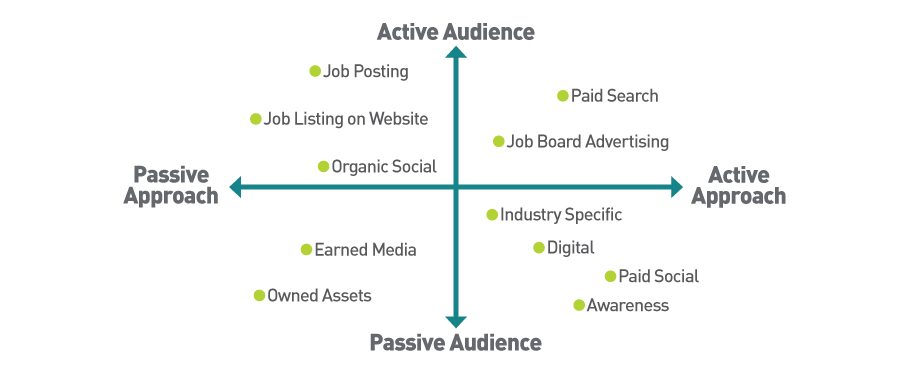Recruiting applicants should be an easy process…you post a job listing, you send it out on all the major job platforms, maybe have your employees share it on social media, and you’re done. Right? Well, not exactly. As many business owners have experienced in 2021, hiring quality applicants is getting harder and harder. In this edition of Plain Talk, we’ll look at the recruitment marketing landscape, what’s changed and how you can fill the empty positions that are hurting your bottom line.
You’re Not Alone
2021’s recruiting challenges, whether for professional positions or unskilled labor, are huge. With the average time to hire nationally hovering around 4 weeks and the regular day-to-day struggles to attract applicants, schedule interviews, onboard, etc., some days it seems like a miracle that we can hire anyone at all! But hire you must, and the need is real. One recent study showed that 42% of business owners had job openings that could not be filled, while 91% of those hiring, or trying to hire, reported fewer or no qualified applicants applying to the open positions.
The Pros and Cons of Job Boards
While there is no question that job boards are a high priority destination for applicants, the problem with the “job-board only” recruiting strategy is that it is a very passive approach to attract only one type of applicant – the “active” job seekers. These people are actively looking for a job – they may be unhappy in their current position, don’t have a job currently, or just need a change. Through PriceWeber’s own research, we found that those who apply for jobs on job boards are typically sending out five to eight applications in a 30-minute timespan. Simply posting a job and hoping someone will stumble upon it may get applications, but these people aren’t applying because they are interested in working for you – they’re casting a wide net and then will pick the highest paying company that contacts them the fastest. In addition, only 25% of employees coming from a job board will stay for more than two years.
Then, there is the passive job seeker – talented individuals who are not actively searching, who are mostly content with their current situation, but may be open to possibilities. Depending on the open position, you could argue that a passive job candidate may be the highest-quality candidate. Reaching these candidates (whether through word of mouth, referral, advertising or direct outreach) will likely land you with a higher-quality employee. Nearly half of those individuals will stay longer than four years. Both are benefits you won’t find on job boards.
Finding Unicorns
Higher-quality candidates with solid experience? Longer tenure? Sounds great, right? So how can you up your recruitment media game to find these unicorns – the ones with real talent! Finding your unicorn employee may be difficult in today’s environment, but there are some key things to keep in mind when developing your process:
1. Who are your trying to reach both in 2021 and in the future? Where do these candidates with the right experience spend their time? What does their typical day look like? Secondary research can help you identify who these people are, how they spend their day and potentially, what media you can use to help reach them. You also have valuable people analytics you can tap into to identify your best current employees and find some commonalities to help target your search for the perfect candidates to contact.
2. When they apply, a candidate or job seeker goes through the same “funnel” as any other consumer – awareness, consideration, interest and then conversion, which in this case is completing the application. Just like with traditional consumer media, multiple touchpoints and a layered approach is always going to work best.
3. Not all media has to be “paid media.” If you are thinking a layered approach to your recruitment marketing has to be expensive, remember that you have “owned” and “shared” media assets like your site and collateral, social media presence and public relations (PR) coverage. All of these can contribute layers that will help you be more effective at finding great candidates. If you are not already, consider collaborating with colleagues in marketing, PR and social media to make sure your recruitment needs are not forgotten.
4. Balance your active and passive approach and find the sweet spot in reaching both active and passive candidates with the right experience.
Six Recruitment Marketing Things You Can Do Now:
Ok, so you are committed to taking your share of unicorns off the market, but what does a balanced strategy look like in 2021? Here are six things you can do now. If done in combination, you’ll be surprised at how well you’ll fill those positions with top talent.
1. Digital Display – Digital display is one of the cheapest, more targetable options to contact who you want, when you need to. There are a ton of ways to target both banner ads and video content (which is more engaging and allows you to better tell your story). Some of our go-to targeting tactics for our clients include IP targeting, behavioral and contextual targeting, and retargeting people who have interacted with your social media or web content. We’ve also had a lot of success in targeting by North American Industry Classification System (NAICS) codes, layering job title targeting on top to reach very specific industries and/or positions.
2. Social Media – Social media is one of the top places that job seekers go to determine the existence of their “deal breakers.” It’s also a valuable tool for HR leaders and recruiters because it can help increase awareness of the company and increase engagement of potential candidates. Active candidates will look at social media shortly after the job boards, and by putting paid media dollars behind your efforts, you can also ensure you increase visibility amongst the more passive candidates. The platform you use should vary based on the type of position you are trying to fill – LinkedIn is an obvious choice (72% of recruiters use and have success here), but Facebook is also successful and may be a better fit for certain positions. Instagram, TikTok and Snapchat have shown increases over the past 3 years in terms of usage and success. There are also industry-specific social sites that would be well worth an investment, giving recruiters a space to scout for top candidates and providing the brand a place to establish thought leadership and category expertise. InMail® and Messenger® are also great ways to check a unicorn’s interest under a cloak of privacy.
3. Paid Search – Creating and maintaining a search presence is a more active approach to reaching those active job seekers. Rather than posting on Indeed or CareerBuilder, sitting back and waiting for the applications to roll in, targeting specific keywords that people may be searching ensures that you contact them at the beginning of their job search journey, regardless of which job platform they gravitate toward.
4. Trade Resources – Industry-specific opportunities should always be considered as a way to get in front of potential future career employees. Whether it’s digitally targeting people at a convention, or creating a splash with a brand sponsorship, you can create name recognition and establish a place in their minds amongst other experts in the industry.
5. Email Marketing –Add email to your process to bridge the gap between active and passive applicants. Maybe someone applies for a job but decides it’s not the right time. Keeping this person on your email list allows you to send out regular communication about your culture, new job postings, blog updates and other news. Just because someone isn’t a fit right now, doesn’t mean they won’t be the talent you need in the future. E-mail is a low-cost way to stay in an applicant’s consideration set and continue to cement your brand and company as a leader in the industry.
6. And Yes, Job Boards Too! – These sites shouldn’t be forgotten. According to eMarketer, active job seekers are most likely to go to job boards first to find a job online, so you can, and should, up your hiring game with these sites. Job boards have a lot of sophisticated targeting options to ensure your brand and jobs are at the top of the list and top of the consideration set. Taking advantage of boosting, company profiles and targeted display or e-blasts will help take your job-board approach from passive to active.
While media is a key piece of employee recruitment and hiring, we also can’t forget good employer branding. Potential employees are checking multiple sources (reviews, social media, friends/word-of-mouth, website, etc.) to see if what you say and what you do match. You can find more information on effective employer brand management here.
Let’s Get Those Unicorns!
Hopefully you feel like we’ve armed you with some useful information to help jump-start your recruitment marketing campaigns. If you have any questions, we hope you’ll drop us a note or give us a call at (502) 499-4209. We’ll be happy to help!



